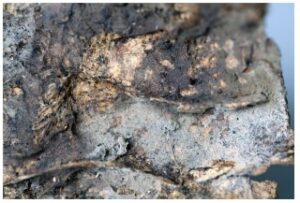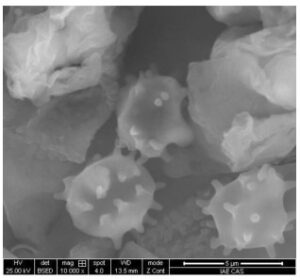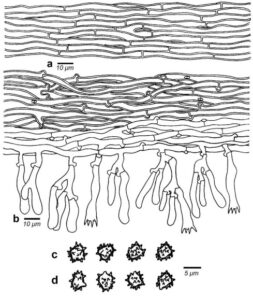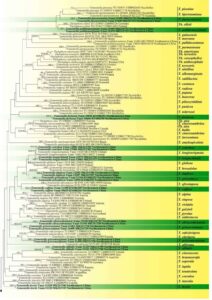Tomentella efibulis H.S. Yuan, X. Lu & Y.C. Dai, sp. nov.
Index Fungorum number: IF 555740; MycoBank number: MB 555740; Facesoffungi number: FoF 05617; Figs. 1, 2, 3
Etymology – Refers to the simple septate hyphae of the rhizomorphs.
Holotype – IFP 019271.
Basidiocarps annual, resupinate, adherent to the substrate, arachnoid, without odour or taste when fresh, 0.2–0.5 mm thick, continuous. Hymenophoral surface granulose, brownish grey to brown (5C2–5F4) and concolorous with subiculum when dry. Sterile margin often determinate, byssoid, concolorous with hymenophore. Rhizomorphs present in subiculum only, 35–55 μm diam; rhizomorphic surface more or less smooth; hyphae in rhizomorph monomitic, undifferentiated, of type B, compactly arranged and of uniform; single hyphae simple septate, thick-walled, rarely branched, 4–5 μm diam, pale brown in KOH, cyanophilous, inamyloid. Subicular hyphae monomitic; generative hyphae clamped and rarely simple septate, thick-walled, occasionally branched, 3–5 μm diam, without encrustation, pale brown in KOH, cyanophilous, inamyloid. Subhymenial hyphae clamped and rarely simple septate, thin-walled, rarely branched, 3–5 μm diam; hyphal cells more or less uniform, pale brown in KOH, acyanophilous, inamyloid. Cystidia absent. Basidia 15–35 μm long and 3–7 μm diam at apex, 2–4 μm at base, with a clamp connection at base, clavate, not stalked, sinuous, without transverse septa, pale brown in KOH and in distilled water, 4-sterigmate; sterigmata 3–5 μm long and 1–1.5 μm diam at base. Basidiospores slightly thick-walled, (4.5–)5–6(6.5)×(4–)4.5–5(–5.5) μm, L=5.36 μm, W=4.54 μm, Q=1.15–1.21 (n=60/2), subglobose to bi-, tri- or quadra-lobed in frontal and lateral views, echinulate, pale brown in KOH and distilled water, cyanophilous, inamyloid; echinuli usually grouped in 2 or more, up to 1 μm long.
Material examined – CHINA, Liaoning Province, Qingyuan County, Experimental Station of Forest Ecology, on fallen angiosperm branch, 3 August 2016, Yuan 11241 (IFP 019271, holotype); Jilin Province. Changbaishan Nature Reserve, on fallen angiosperm branch, 7 August 2016, Yuan 11329 (IFP 019272).
GenBank numbers – ITS: MK211708, MK211709; LSU: MK446361, MK446362.
Notes – Tomentella cinerascens (P. Karst.) Höhn. & Litsch. and T. efibulis formed a clade with high support in our phylogeny (Fig. 4). Both species have greyish brown and arachnoid basidiocarps, the presence of rhizomorphs and the absence of cystidia. However, T. cinerascens differs from T. efibulis by the thin-walled and clamped rhizomorphic hyphae, and globose to subglobose basidiospores (Kõljalg 1996; Daemmrich 2006; Melo et al. 2006). T. asperula (P. Karst.) Höhn. & Litsch. resembles T. eifibulis by having arachnoid basidiocarps with a granulose hymenophoral surface, a byssoid sterile margin, the presence of rhizomorphs and the absence of cystidia. However, the former species is differentiated by thin-walled and clamped rhizomorphic hyphae, and globose to subglobose basidiospores (Larsen 1970; Daemmrich 2006).

Figure 1 – A basidiocarp of Tomentella efibulis (IFP 019271, holotype)

Figure 2 –SEM of basidiospores of Tomentella efibulis (IFP 019271, holotype)

Figure 3 – Microscopic structures of Tomentella efibulis (IFP 019271, holotype). a Hyphae from a rhizomorph. b Section through a basidiocarp. c Basidiospores in lateral view. d Basidiospores in frontal view

Figure 4 – Phylogenetic position of Tomentella species inferred from the ITS sequences. Bootstrap support values for ML≥50% and Bayesian posterior probabilities≥0.95 are given near nodes respectively. The tree is rooted with Odontia fibrosa (TU115714). The new species are in bold
